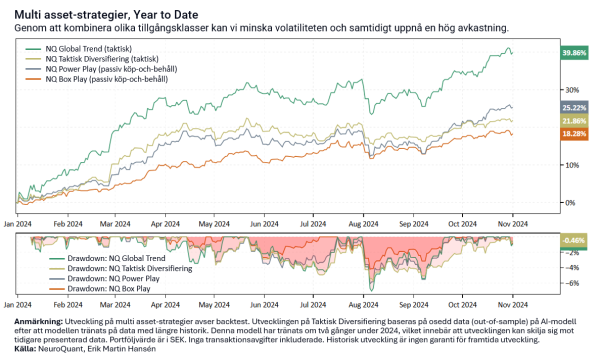Update: Global asset allocation (multi assets)

Prioritize survival over maximum return! With global asset allocation, we build capital over time, without having to expose ourselves to the emotional roller coaster of the stock market.
The path to the goal is crucial to succeeding with a long-term perspective and achieving success. With the help of a diversified base portfolio, we build a stable foundation that provides security and allows us to do well, regardless of how our stock or trading portfolios develop.
Asset allocation optimizes return in relation to risk and is an important part of risk management for total capital. It can be done according to different strategies depending on goals and market view – for example static/strategic or tactical asset allocation.
“You should have a strategic asset allocation mix that assumes that you don’t know what the future is going to hold“. – Ray Dalio
Owning 100% stocks may work well in theory, but in practice it is often less effective for most people. The best strategy is one that we can stick to over time, and by reducing portfolio volatility, we increase the chances that we can be long-term. What works best for you, of course, depends on your unique needs and life situation.
Why is interest in asset allocation low?
Many private investors place greater emphasis on pure returns and are often attracted by large profit opportunities without fully considering the risk taken to achieve these results. This can be due to several factors:
- Knowledge level: Many retail investors have limited experience analyzing risk and risk-adjusted returns. They may not be familiar with metrics such as Sharpe ratio, volatility or risk-adjusted returns, and therefore focus more on absolute returns.
- Short-term focus: Private investors are sometimes more short-term in their investment behavior, which can lead them to chase quick profits without considering long-term risk management.
- Higher risk appetite or ignorance of risk: Many people have a natural appetite for risk when they start investing and may therefore ignore risk adjustment measures to maximize potential returns. Sometimes it can also be a lack of understanding of how risk works and the impact it can have on a portfolio over time.
- Failure to diversify: Retail investors often have a less diversified portfolio, meaning that a single investment can have a large impact on the portfolio's overall return and risk profile. Professional investors, on the other hand, tend to use a structured asset allocation to create a more balanced risk-adjusted return.
- Lack of understanding of market cycles: Many retail investors can become over-enthusiastic during bull markets and take on too much risk, which can lead to large losses in downturns. Ambitious investors often work with risk adjustment to manage market cycles and maintain stable growth even during volatile periods.
Experienced or ambitious investors, on the other hand, tend to focus heavily on maximizing risk-adjusted returns. They work on risk management, diversification, and continuously balancing the portfolio to achieve a more stable and long-term sustainable return.
Development of multi-asset strategies
October was a weak month for the stock market, but our multi-asset strategies managed to withstand increased risk aversion. NQ Global Trend and NQ Power Play were the best performers, supported by both gold and bitcoin.
Development strategies October 2024
- NQ Box Play (Strategic buy and hold): +0.8%
- NQ Power Play (Strategic buy and hold): +3.9%
- NQ Global Trend (Tactical allocation with trend following): +3.9%
- NQ Tactical Diversification (Dynamic allocation with AI): +1.4%
Development 2024 (Year to Date)
 Current allocation multi-asset strategies
Current allocation multi-asset strategies
We offer strategic (passive) and tactical asset allocation with different levels of risk. These portfolios are intended as inspiration for how we can create exposure to multiple asset classes, reduce volatility while generating good returns.
Changes and current holdings
Login required to view holdings in our stock strategies
Not a customer? Open an account to access our analytics service.